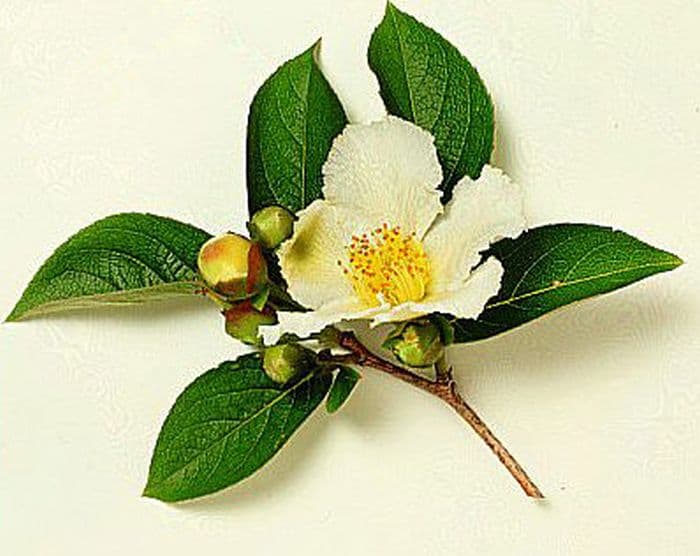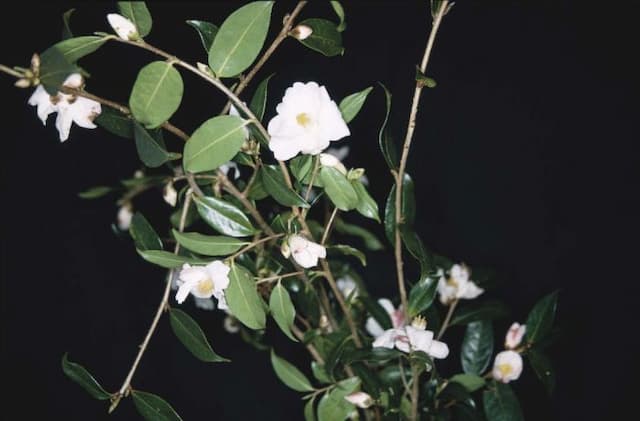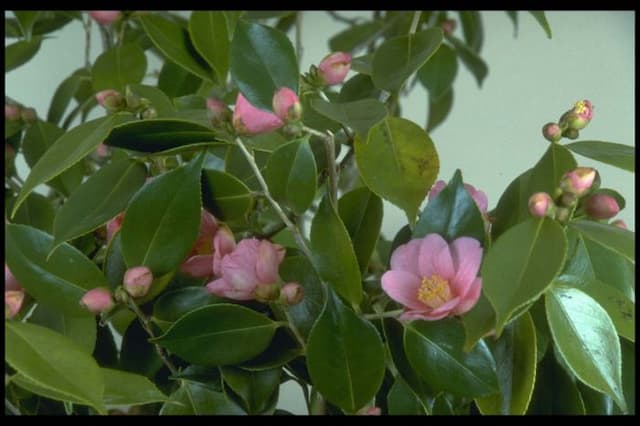Korean Stewartia Stewartia pseudocamellia Koreana Group

ABOUT
Stewartia pseudocamellia Koreana Group, commonly known as the Korean stewartia, is a deciduous tree noted for its stunning display through multiple seasons. The most eye-catching feature of this plant is its camellia-like flowers which are typically white with orange centers, blooming prolifically in early to mid-summer. The petals of the flower are beautifully arranged in a somewhat loose and open cup shape. The Korean stewartia's leaves are also attractive, showcasing ovate to elliptical shapes with finely serrated edges. They offer a rich green color through the spring and summer, before transitioning to a vibrant display of oranges, reds, and purples in the fall. This vivid autumn foliage offers a striking contrast in the landscape. Its bark is another distinguishing feature, exfoliating in a mottled pattern of gray, brown, and orange, giving the tree an additional point of interest even in winter when the leaves have fallen. The overall form of the Korean stewartia is broadly pyramidal to oval, providing a structured yet somewhat graceful silhouette. The plant's branching structure adds to its ornamental value, with well-distributed branches that give it a balanced appearance. The Korean stewartia also bears seed capsules which add a textural quality to the tree. The seeds inside these capsules can be a food source for wildlife during the colder months. This plant's exquisite combination of flowers, foliage, bark, and form makes it a highly prized specimen for gardens and landscapes, providing year-round interest without reliance on large dimensions.
About this plant
 Names
NamesFamily
Theaceae
Synonyms
Korean Stewartia, Korean Mountain Camellia
Common names
Stewartia pseudocamellia var. koreana.
 Toxicity
ToxicityTo humans
The Korean Stewartia is generally considered non-toxic to humans. There are no widespread reports of poisoning or adverse effects from ingesting this plant. As with any plant material, individual allergies or sensitivities could occur, but such cases are rare.
To pets
The Korean Stewartia is also generally considered non-toxic to pets. It should not pose a significant risk if pets happen to ingest parts of the plant. However, as with humans, individual cases of sensitivity or gastrointestinal upset could potentially occur due to ingestion of plant matter that is not part of the normal diet.
 Characteristics
CharacteristicsLife cycle
Perennials
Foliage type
Deciduous
Color of leaves
Green
Flower color
White
Height
20-30 feet (6-9 meters)
Spread
15-25 feet (4.5-7.5 meters)
Plant type
Tree
Hardiness zones
5
Native area
Korea
Benefits
 General Benefits
General Benefits- Ornamental Value: Stewartia pseudocamellia Koreana Group, commonly known as Korean Stewartia, has stunning white flowers that add aesthetic beauty to gardens.
- Four-Season Interest: This plant offers year-round visual interest with flowers in summer, colorful foliage in fall, and decorative bark in winter.
- Shade Tolerance: Korean Stewartia can thrive in partially shaded areas where other plants might struggle, making it a versatile choice for different garden spots.
- Wildlife Attraction: The flowers provide nectar for pollinators such as bees, while birds are attracted to the habitat the tree provides.
- Low Maintenance: Once established, this plant requires minimal care, making it a practical option for gardeners of all skill levels.
- Resistant to Pests: It is generally resistant to pests, decreasing the need for chemical treatments.
- Adaptability: Korean Stewartia is adaptable to a range of soil conditions, though it prefers well-drained, acidic soils.
- Urban Tolerant: The plant can tolerate urban pollution, making it suitable for city landscapes and street plantings.
- Non-Invasive: This species is not known to be invasive, ensuring that it will not disrupt local ecosystems.
- Size Control: It grows to a moderate size, making it appropriate for smaller gardens without the risk of it growing too large.
 Medical Properties
Medical PropertiesThis plant is not used for medical purposes.
 Air-purifying Qualities
Air-purifying QualitiesThis plant is not specifically known for air purifying qualities.
 Other Uses
Other Uses- Woodworking: The wood of Korean Stewartia can be used for fine woodworking projects including furniture and inlays due to its hardness and attractive grain.
- Photography Background: The tree, especially when in bloom, provides a beautiful backdrop for outdoor photography thanks to its striking flowers.
- Bonsai: Korean Stewartia can be trained as a bonsai, offering year-round interest with its changing leaves and winter bark.
- Artistic Inspiration: Artists may use the Korean Stewartia as a subject in paintings or drawings due to its beautiful flowers and striking bark.
- Educational Tool: Botanical gardens and schools may utilize this plant for educational purposes such as botany and horticulture studies.
- Winter Garden Interest: With its exfoliating bark, Korean Stewartia provides textural interest in winter gardens where many plants are dormant.
- Fall Foliage Tours: This tree could be earmarked as a point of interest in fall foliage tours because of its vibrant autumn leaf colors.
- Dendrology Study: Due to its distinct characteristics, Korean Stewartia can be included in the study of trees and shrubs for science and research.
- Bridal Settings: The tree could be planted in wedding gardens for its picturesque appearance, especially when the flowers are in full bloom.
- Eco-friendly Crafting Material: Fallen leaves and bark of Korean Stewartia can serve as eco-friendly crafting materials for creative projects.
Interesting Facts
 Feng Shui
Feng ShuiThe Korean Stewartia is not used in Feng Shui practice.
 Zodiac Sign Compitability
Zodiac Sign CompitabilityThe Korean Stewartia is not used in astrology practice.
 Plant Symbolism
Plant Symbolism- Beauty and Refinement: The Stewartia pseudocamellia, commonly known as the Korean Stewartia, is often associated with beauty and refinement, owing to its attractive, camellia-like flowers and striking, exfoliating bark.
- Perseverance and Longevity: With its hardy nature and ability to thrive in various conditions, the Korean Stewartia symbolizes perseverance and the ability to withstand the test of time.
- Change and Transformation: The peeling bark, which reveals layers of color underneath, represents change and transformation, much like the evolving periods in a person's life.
- Uniqueness: The unique beauty of the Korean Stewartia's flowers and bark sets it apart from others, symbolizing uniqueness and encouraging appreciation of one's individuality.
 Water
WaterKorean Stewartia requires consistent moisture, so it is important to water the plant regularly but avoid waterlogging. Typically, watering should occur once a week, applying about 1 to 1.5 gallons of water for each watering session, depending on the weather conditions and soil moisture levels. During hot or dry seasons, the frequency may need to increase to twice a week, ensuring the soil remains moist but not soggy. In cooler or rainy periods, reduce watering to prevent over-saturation of the soil.
 Light
LightKorean Stewartia prefers a location with partial shade to full sun. The ideal spot would be where the plant can receive morning sunlight and protection from the intense afternoon sun, which can prevent leaf scorch. Placing the Stewartia pseudocamellia Koreana Group in an area with dappled sunlight throughout the day is ideal for maintaining healthy foliage and encouraging flowering.
 Temperature
TemperatureKorean Stewartia thrives in a temperature range between 60°F and 80°F, which are the ideal growing conditions. It can tolerate minimum temperatures down to about 20°F but should be protected from frost. Maximum temperatures should not exceed 90°F to maintain plant health and reduce stress. This plant prefers consistent and moderate temperatures without the extremes.
 Pruning
PruningPrune Korean Stewartia to maintain shape and remove any dead or diseased wood. It requires minimal pruning, only to enhance its natural form. The best time for pruning is in late winter or early spring before new growth starts. Light pruning can be done annually, but a thorough shaping should be done every few years as needed to preserve the plant's structure and health.
 Cleaning
CleaningAs needed
 Soil
SoilKorean Stewartia prefers acidic to neutral soil with a pH of 5.5 to 6.5. The best soil mix for this plant is a well-draining mixture with equal parts of loamy soil, peat moss, and perlite or pine bark to retain moisture and allow excess water to escape. Regularly amend with organic matter to keep the soil fertile and well-aerated.
 Repotting
RepottingKorean Stewartia should be repotted every few years as it grows or if the soil is exhausted. It's best to repot in early spring before new growth starts. Transplant into a slightly larger container with fresh soil to encourage continued growth and health.
 Humidity & Misting
Humidity & MistingKorean Stewartia thrives in moderate to high humidity levels. Ideally, maintain humidity around 40-60%. While the plant does enjoy humidity, it is quite adaptable and can tolerate lower levels, especially when grown outdoors in its natural environment.
 Suitable locations
Suitable locationsIndoor
Place Korean Stewartia near a bright window; keep moist.
Outdoor
Plant in partial shade, sheltered from harsh sun and wind.
Hardiness zone
5-8 USDA
 Life cycle
Life cycleKorean stewartia begins its life cycle as a seed, which, once germinated, develops into a seedling showcasing the first leaves to perform photosynthesis. As the seedling grows, it matures into a young plant, undergoing vegetative growth and developing a woody stem and true leaves characteristic of the species. After reaching maturity, which can take several years, Korean stewartia enters the reproductive stage, producing striking white flowers with conspicuous yellow centers that attract pollinators. Following pollination, fertilized flowers produce a dry, dehiscent fruit called a capsule that releases seeds, thus enabling the next generation. During its lifetime, which may span decades, the plant undergoes periods of active growth in spring and summer, followed by dormancy in fall and winter when leaves change color and drop. With proper conditions, this cycle repeats annually, with the plant continuing to grow in size and produce flowers and seeds each year.
 Propogation
PropogationPropogation time
Late winter to early spring
The Korean Stewartia, Stewartia pseudocamellia Koreana Group, is commonly propagated through seeds, as this is the most popular method used. The best time for sowing seeds of Korean Stewartia is in the fall, directly after they are collected. Since the seeds possess a certain level of dormancy, it's beneficial to stratify them at 40 degrees Fahrenheit (4.4 degrees Celsius) for about 90 days. This cold treatment helps to break the seed dormancy, increasing the chances of successful germination. They should then be sown in a well-draining soil mix, covering lightly with soil and kept consistently moist. Germination can be slow and irregular, often occurring in the spring or sometimes the following year. Care should be taken to avoid deep planting, as shallow sowing increases germination success.









